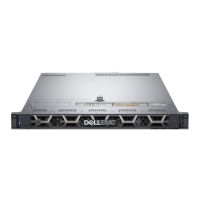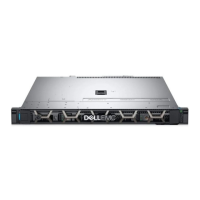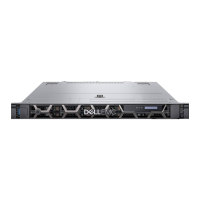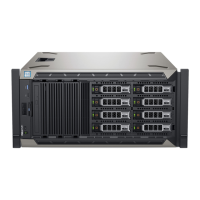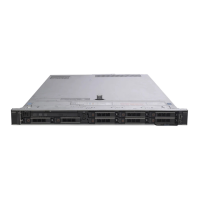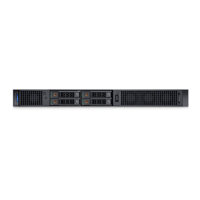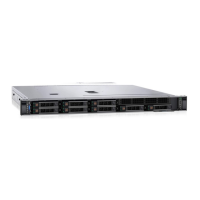Do you have a question about the Dell EMC VxRail E560 Series and is the answer not in the manual?
Guidance on accessing Dell EMC online support resources and registering your VxRail appliance.
Step-by-step instructions for creating an online support account to access product resources.
Methods to find the VxRail appliance serial number and service tag for support purposes.
List of available documents for VxRail core administration, support, API, and hardware.
Description of the front panel components, including buttons, ports, and diagnostic LEDs.
Details the indicators and buttons on the left control panel of the appliance.
Explanation of the status LED indicators and their meanings for appliance health.
Codes for appliance health and ID indicators, indicating status and faults.
Details the ports, buttons, and LEDs on the right control panel of the appliance.
Description of the ports and components located on the back of the appliance.
Explanation of drive activity and status LED indicators on the hard drive carriers.
Explanation of link and activity indicators for the Network Interface Controller (NIC) ports.
Explanation of status indicators for both AC and DC power supply units (PSUs).
Explanation of the status indicators for the iDRAC Direct port.
Details the physical dimensions (height, width, depth) of the VxRail appliance.
Provides the maximum weight specifications for the VxRail E560 Series appliance.
Lists the supported Intel Xeon Processor Scalable Family processors for the appliance.
Details the specifications for the 1100W AC and DC power supply units (PSUs).
Describes the PCI Express (PCIe) generation 3 expansion card capabilities.
Details memory types (LRDIMM, RDIMM), capacities, and configurations.
Lists the supported internal storage controller cards like HBA330 and BOSS-S1.
Lists the supported NVMe, SAS, SATA, and Nearline SAS hard drives or SSDs.
Details specifications for USB, NIC, VGA, and serial ports.
Outlines temperature, humidity, vibration, shock, and altitude limits for the appliance.
Defines limitations for particulates and gaseous pollution to prevent equipment damage.
Specifies the standard operating temperature range (10°C to 35°C) for the appliance.
Details operating temperature ranges beyond standard conditions and de-rating factors.
Lists restrictions and requirements for operating within the expanded temperature range.
Lists configurations required for efficient cooling, including heatsinks and fans.
Lists configurations requiring ambient temperature below 35°C for proper cooling and performance.
Lists options for managing pre-operating system applications like System Setup and iDRAC.
Explains the Integrated Dell Remote Access Controller (iDRAC) and how to log in and configure it.
Guides users on using Solve Online for hardware replacement and administrative tasks.
Lists hardware components supported for replacement or addition as CRU or FRU.
Details memory types (LRDIMM, RDIMM), capacities, and installation locations.
Explains expansion cards, riser cards, and installation guidelines for enhanced functionality.
Provides general guidelines for optimal memory module installation to ensure system stability.
Offers guidelines for installing expansion cards and risers for proper cooling and fit.
Guidance on accessing Dell EMC online support resources and registering your VxRail appliance.
Step-by-step instructions for creating an online support account to access product resources.
Methods to find the VxRail appliance serial number and service tag for support purposes.
List of available documents for VxRail core administration, support, API, and hardware.
Description of the front panel components, including buttons, ports, and diagnostic LEDs.
Details the indicators and buttons on the left control panel of the appliance.
Explanation of the status LED indicators and their meanings for appliance health.
Codes for appliance health and ID indicators, indicating status and faults.
Details the ports, buttons, and LEDs on the right control panel of the appliance.
Description of the ports and components located on the back of the appliance.
Explanation of drive activity and status LED indicators on the hard drive carriers.
Explanation of link and activity indicators for the Network Interface Controller (NIC) ports.
Explanation of status indicators for both AC and DC power supply units (PSUs).
Explanation of the status indicators for the iDRAC Direct port.
Details the physical dimensions (height, width, depth) of the VxRail appliance.
Provides the maximum weight specifications for the VxRail E560 Series appliance.
Lists the supported Intel Xeon Processor Scalable Family processors for the appliance.
Details the specifications for the 1100W AC and DC power supply units (PSUs).
Describes the PCI Express (PCIe) generation 3 expansion card capabilities.
Details memory types (LRDIMM, RDIMM), capacities, and configurations.
Lists the supported internal storage controller cards like HBA330 and BOSS-S1.
Lists the supported NVMe, SAS, SATA, and Nearline SAS hard drives or SSDs.
Details specifications for USB, NIC, VGA, and serial ports.
Outlines temperature, humidity, vibration, shock, and altitude limits for the appliance.
Defines limitations for particulates and gaseous pollution to prevent equipment damage.
Specifies the standard operating temperature range (10°C to 35°C) for the appliance.
Details operating temperature ranges beyond standard conditions and de-rating factors.
Lists restrictions and requirements for operating within the expanded temperature range.
Lists configurations required for efficient cooling, including heatsinks and fans.
Lists configurations requiring ambient temperature below 35°C for proper cooling and performance.
Lists options for managing pre-operating system applications like System Setup and iDRAC.
Explains the Integrated Dell Remote Access Controller (iDRAC) and how to log in and configure it.
Guides users on using Solve Online for hardware replacement and administrative tasks.
Lists hardware components supported for replacement or addition as CRU or FRU.
Details memory types (LRDIMM, RDIMM), capacities, and installation locations.
Explains expansion cards, riser cards, and installation guidelines for enhanced functionality.
Provides general guidelines for optimal memory module installation to ensure system stability.
Offers guidelines for installing expansion cards and risers for proper cooling and fit.


